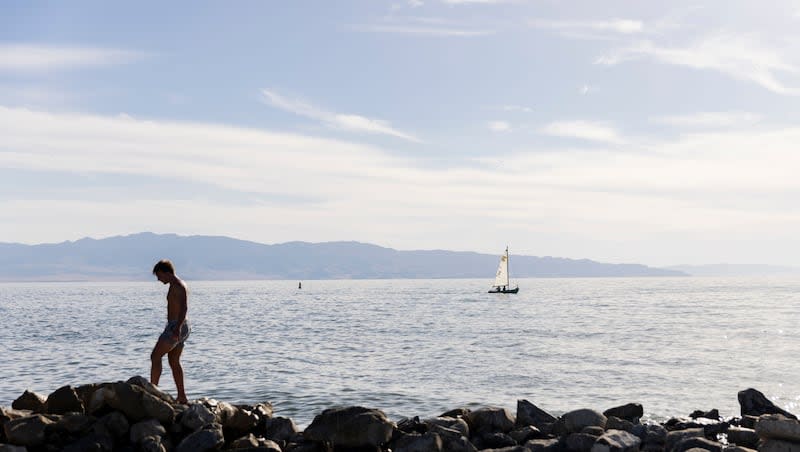Why this summer probably won’t be an ‘anomaly’ for the Great Salt Lake

Editor's note: This article is published through the Great Salt Lake Collaborative, a solutions journalism initiative that partners news, education and media organizations to help inform people about the plight of the Great Salt Lake.
SALT LAKE CITY — The Great Salt Lake typically rises in the winter and spring as more water flows into the lake from snowpack runoff and fewer upstream diversions; it then drops in the summer and early fall as evaporation and irrigation season diversions pick up.
It dropped to record lows in 2021 and 2022 after this delicate balance fell apart over about two decades, resulting in more losses than gains.
Even after the lake rebounded from its record low last year, its southern arm lost about 2 feet from its springtime peak. But last summer was also an "anomaly," says Tim Davis, Utah's Great Salt Lake deputy commissioner. The berm separating the lake's southern arm from its northern arm was closed, and it wasn't particularly hot and dry for that long throughout Utah.
That's why Davis isn't surprised the lake is dropping quickly after its southern arm — the side of the lake most people think of when they talk about the lake — peaked at 4,195.2 feet this year, its highest in five years.
The southern arm has lost about half a foot over the past few weeks, and the Office of the Great Salt Lake Commissioner expects the lake will at least drop the normal amount of 2-2.5 feet before it starts to rebound in October or November.
"People shouldn't be surprised. We'll still see the lake probably fall down another 2 feet from where it is today," Davis told KSL NewsRadio on Thursday.
Experts believe the lake could drop more this summer than last summer because of two key reasons.
First, Utah leaders agreed to open the berm so more water could flow into the northern arm, thus spreading out the water the lake gained this year more than last year. The lake's northern arm remains at 4,192.1 feet elevation, close to its peak this year and nearly 3 feet above where it was this time last year.
Second, June has been quite hot and mostly dry and there aren't signs of that changing this summer.
With an average temperature of 77.3 degrees through Wednesday, Salt Lake City is on pace to produce its fourth-hottest June on record, but this month still has a shot at placing as high as second, per National Weather Service data. Utah's capital city, named after the lake, has only gained rain from one storm that dropped 0.31 inches last week.
Long-range outlooks indicate the region could get some precipitation over the next week, but odds are pointing in favor of hotter- and drier-than-normal conditions persisting throughout most of this summer.
Since the Great Salt Lake's water is spread out over more areas, the lake isn't very deep along its edges. These shallow and warm edges then become more prone to evaporative loss, Great Salt Lake Commissioner Brian Steed explained in April.
For this reason, Steed wasn't thrilled when the long-range outlooks started to lean toward hotter and drier conditions setting up along the Great Salt Lake Basin. "If that continues into the summer, we would anticipate to see a higher evaporation loss, which is something that would concern us," he said at the time.
Evaporation is generally something that is out of the control of the commissioner's office, but there are ways to combat this — something the state is still trying to figure out. There are ongoing efforts to send more water to the lake during the irrigation season through donated water, water leasing or simply cutting back on water consumption.
Davis said the commissioner's office continues to meet with municipalities, farmers, mineral companies and other groups to figure out the best way to reduce upstream diversions and other factors that play into the lake's demise. The agency also encourages residents to find ways to conserve water while it works on a more detailed 30-year plan for the lake.
The message of cutting back, Davis adds, has just as much to do with the uncertainty of the next water year as it does with the current evaporation. Nobody knows if Utah will get a third straight wet winter after a slew of dry ones over the past two decades.
"Conservation is no longer just a warm, dry year thing that we have to do. We really have to conserve water and dedicate it to the lake every year," he said. "It'll take every sector and everyone in the basin to do that."
Contributing: Adam Small

